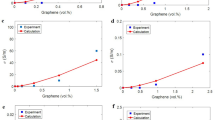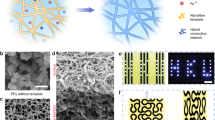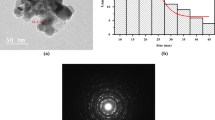Abstract
In this study, doped films consisting of a nanofiber network of a conducting polymer, poly(3-hexylthiophene), were fabricated, and optical transmittance and electrical conductivity measurements were carried out. It was found that the films could be doped more efficiently than the conventional non-nanofibrillar polymer films by dipping the films in a dopant solution. The conductivity of the nanofiber films was 34 S cm,−1 which was seven times larger than that of a conventional polymer film with the same transmittance (∼85%). The superior transparency and conductivity properties of the nanofiber films were attributed to the existence of highly effective conducting pathways, a large void fraction generated by the bulky network of the nanofibers, and a high dopant concentration that results from the large surface area.
Similar content being viewed by others
Log in or create a free account to read this content
Gain free access to this article, as well as selected content from this journal and more on nature.com
or
References
Zhang, H. & Li, C. Chemical synthesis of transparent and conducting polyaniline-poly(ethylene terephthalate) composite films. Synth. Met. 44, 143 (1991).
Cao, Y., Treacy, G. M., Smith, P. & Heeger, A. J. Solution-cast films of polyaniline: optical-quality transparent electrodes. Appl. Phys. Lett. 60, 2711 (1992).
Cao, Y., Treacy, G. M., Smith, P. & Heeger, A. J. Optical-quality transparent conductive polyaniline films. Synth. Met. 57, 3526 (1993).
Byun, S. W. & Im, S. S. Degradation kinetics of electrical conductivity in transparent polyaniline-nylon 6 composite films. Synth. Met. 69, 219 (1995).
Wan, M. X., Li, M., Li, J. C. & Liu, Z. X. Transparent and conducting coatings of polyaniline composite. Thin Solid Films 259, 188 (1995).
Bayer, A. G. New polythiophene dispersions, their preparation and their use. European Patent 440957 (1991).
Gevaert, Agfa. Antistatic plastic parts. European Patent 564911 (1993).
Jonas, F., Krafft, W. & Muys, B. Poly(3, 4-ethylenedioxythiophene): conductive coatings, technical applications and properties. Macromol. Symp. 100, 169 (1995).
Groenendaal, L. B., Jonas, F., Freitag, D., Pielartzik, H. & Reynolds, J. R. Poly(3,4-ethylenedioxythiophene) and its derivatives: Past, present, and future. Adv. Mater. 12, 481 (2000).
Yan, H., Jo, T. & Okuzaki, H. Highly conductive and transparent poly(3,4-ethylenedioxythiophene)/poly(4-styrenesulfonate) thin films. Polym. J. 41, 1028 (2009).
Apperloo, J. J., van Haare, J. A. E. H. & Janssen, R. A. J. Transparent highly oxidized conjugated polymer films from solution. Synth. Met. 101, 417 (1999).
Park, J. G., Kim, G. T., Kristic, V., Kim, B., Lee, S. H., Roth, S., Burghard, M. & Park, Y. W. Nanotransport in polyacetylene single fiber: toward the intrinsic properties. Synth. Met. 119, 53 (2001).
Aleshin, A. N., Lee, H. J., Park, Y. W. & Akagi, K. One-dimensional transport in polymer nanofibers. Phys. Rev. Lett. 93, 196601 (2004).
Pinto, N. J., Johnson, A. T., MacDiarmid, A. G., Mueller, C. H., Theofylaktos, N., Robinson, D. C. & Miranda, F. A. Electrospun polyaniline/polyethylene oxide nanofiber field-effect transistor. Appl. Phys. Lett. 83, 4244 (2003).
Huang, J. & Kaner, R. B. A general chemical route to polyaniline nanofibers. J. Am. Chem. Soc. 126, 851 (2004).
Wan, M., Wei, Z., Zhang, Z., Zhang, L., Huang, K. & Yang, Y. Studies on nanostructures of conducting polymers via self-assembly method. Synth. Met. 135–136, 175 (2003).
Ihn, K. J., Moulton, J. & Smith, P. Whiskers of poly (3-alkylthiophene)s. J. Polym. Sci. Part B: Polym. Phys. 31, 735 (1993).
Merlo, J. A. & Frisbie, D. Field effect conductance of conducting polymer nanofibers. J. Polym. Sci. Part B: Polym. Phys. 41, 2674 (2003).
Wang, Y. & Jing, X. Transparent conductive thin films based on polyaniline nanofibers. Mater. Sci. Eng. B 138, 95 (2007).
Samitsu, S., Shimomura, T., Heike, S., Hashizume, T. & Ito, K. Field-effect carrier transport in poly(3-alkylthiophene) nanofiber networks and isolated nanofibers. Macromolecules 43, 7891 (2010).
Shimomura, T., Takahashi, T., Ichimura, Y., Nakagawa, S., Noguchi, K., Heike, S. & Hasuizume, T. Relationship between structural coherence and intrinsic carrier transport in an isolated poly(3-hexylthiophene) nanofiber. Phys. Rev. B 83, 115314 (2011).
Merlo, J. A. & Frisbie, C. D. Field effect transport and trapping in regioregular polythiophene nanofibers. J. Phys. Chem. B 108, 19169 (2004).
Chang, J. F., Sun, B. Q., Breiby, D. W., Nielsen, M. M., Solling, T. I., Giles, M., McCulloch, I. & Sirringhaus, H. Enhanced mobility of poly(3-hexylthiophene) transistors by spin-coating from high-boiling-point solvents. Chem. Mater. 16, 4772 (2004).
Mas-Torrent, M., den Boer, D., Durkut, M., Hadley, P. & Schenning, A. P. H. J. Field effect transistors based on poly(3-hexylthiophene) at different length scales. Nanotechnology 15, S265 (2004).
Yang, H. C., Shin, T. J., Yang, L., Cho, K., Ryu, C. Y. & Bao, Z. N. Effect of mesoscale crystalline structure on the field-effect mobility of regioregular poly(3-hexyl thiophene) in thin-film transistors. Adv. Func. Mater. 15, 671 (2005).
Kim, D. H., Jang, Y., Park, Y. D. & Cho, K. Controlled one-dimensional nanostructures in poly(3-hexylthiophene) thin film for high-performance organic field-effect transistors. J. Phys. Chem. B 110, 15763 (2006).
Liu, J. H., Arif, M., Zou, J. H., Khondaker, S. I. & Zhai, L. Controlling poly(3-hexylthiophene) crystal dimension: nanowhiskers and nanoribbons. Macromolecules 42, 9390 (2009).
Oosterbaan, W. D., Bolsee, J. C., Gadisa, A., Vrindts, V., Bertho, S., D’Haen, J., Cleij, T. J., Lutsen, L., McNeill, C. R., Thomsen, L., Manca, J. V. & Vanderzande, D. Alkyl-chain-length-independent hole mobility via morphological control with poly(3-alkylthiophene) nanofibers. Adv. Func. Mater. 20, 792 (2010).
Minami, T., Sato, H., Nanto, H. & Takata, S. Group III impurity doped zinc oxide thin films prepared by RF magnetron sputtering. Jpn J. Appl. Phys. 24, L781 (1985).
Maissel, L. I. in Handbook of Thin Film Technology (eds Maissel, L. I. & Glang, R.) Ch. 13 (McGraw-Hill, New York, 1970).
Kivelson, S. & Heeger, A. J. First order phase transition to a metallic state in PA: A strong-coupling polaronic metal. Phys. Rev. Lett. 55, 308 (1985).
Kim, J., Sohn, D., Sung, Y. & Kim, E.-R. Fabrication and characterization of conductive polypyrrole thin film prepared by in situ vapor-phase polymerization. Synth. Met. 132, 309 (2003).
Acknowledgements
This work was supported in part by a grant-aid for Scientific Research (B) (No. 20350102) from the Ministry of Education, Culture, Sports, Science and Technology of Japan, and an Adaptable and Seamless Technology Transfer Program through Target-Driven R&D (AS231Z04000D) from the Japan Science and Technology Agency.
Author information
Authors and Affiliations
Corresponding author
Rights and permissions
About this article
Cite this article
Aronggaowa, B., Kawasaki, M. & Shimomura, T. Thin, transparent conductive films fabricated from conducting polymer nanofibers. Polym J 45, 819–823 (2013). https://doi.org/10.1038/pj.2012.214
Received:
Revised:
Accepted:
Published:
Issue date:
DOI: https://doi.org/10.1038/pj.2012.214
Keywords
This article is cited by
-
Synthesis and characterization of WO3-doped polyaniline to sense biomarker VOCs of Malaria
Applied Nanoscience (2021)
-
Fabrication of reduced graphene oxide modified poly(3,4-ethylenedioxythiophene) polystyrene sulfonate based transparent conducting electrodes for flexible optoelectronic application
SN Applied Sciences (2021)



